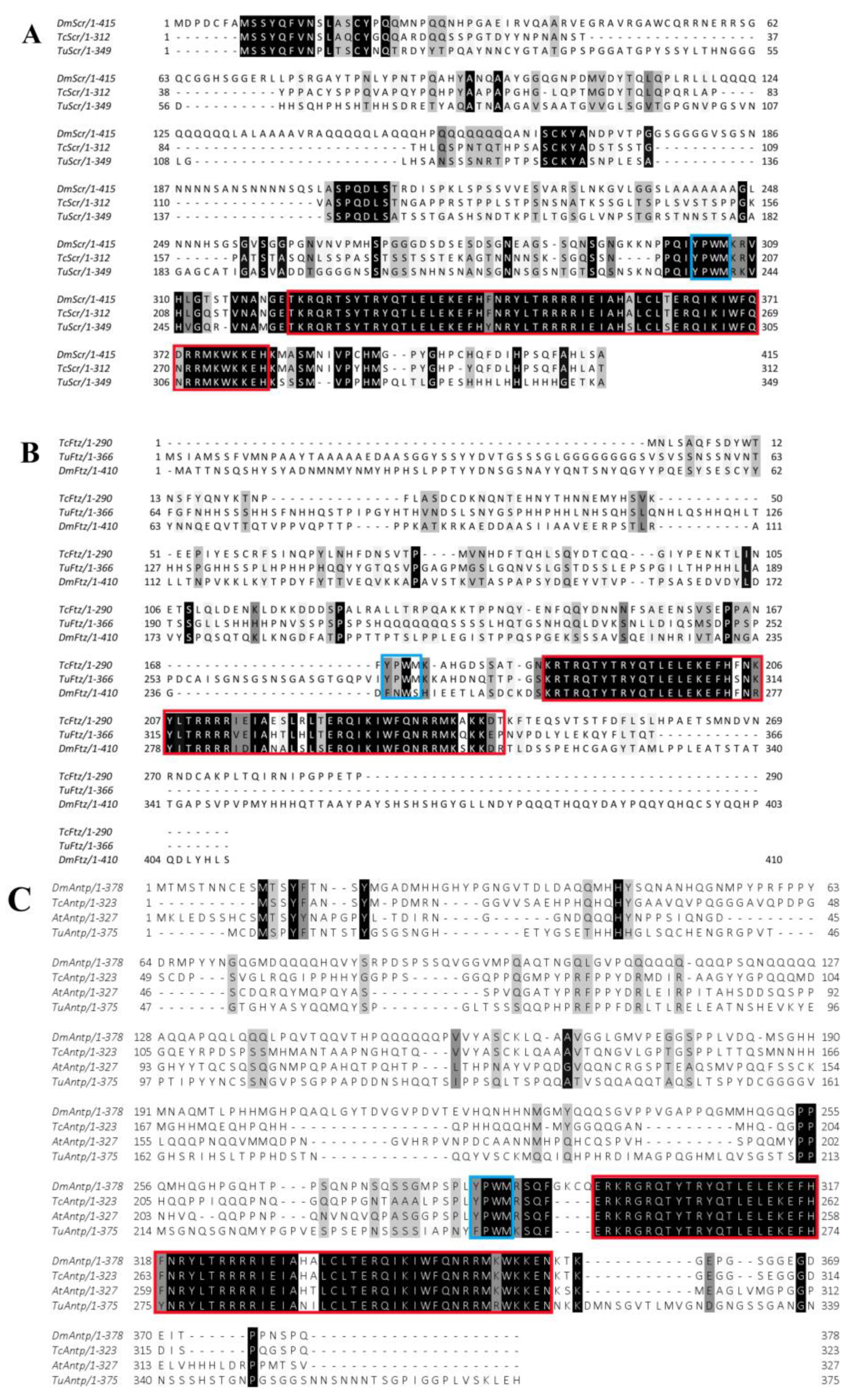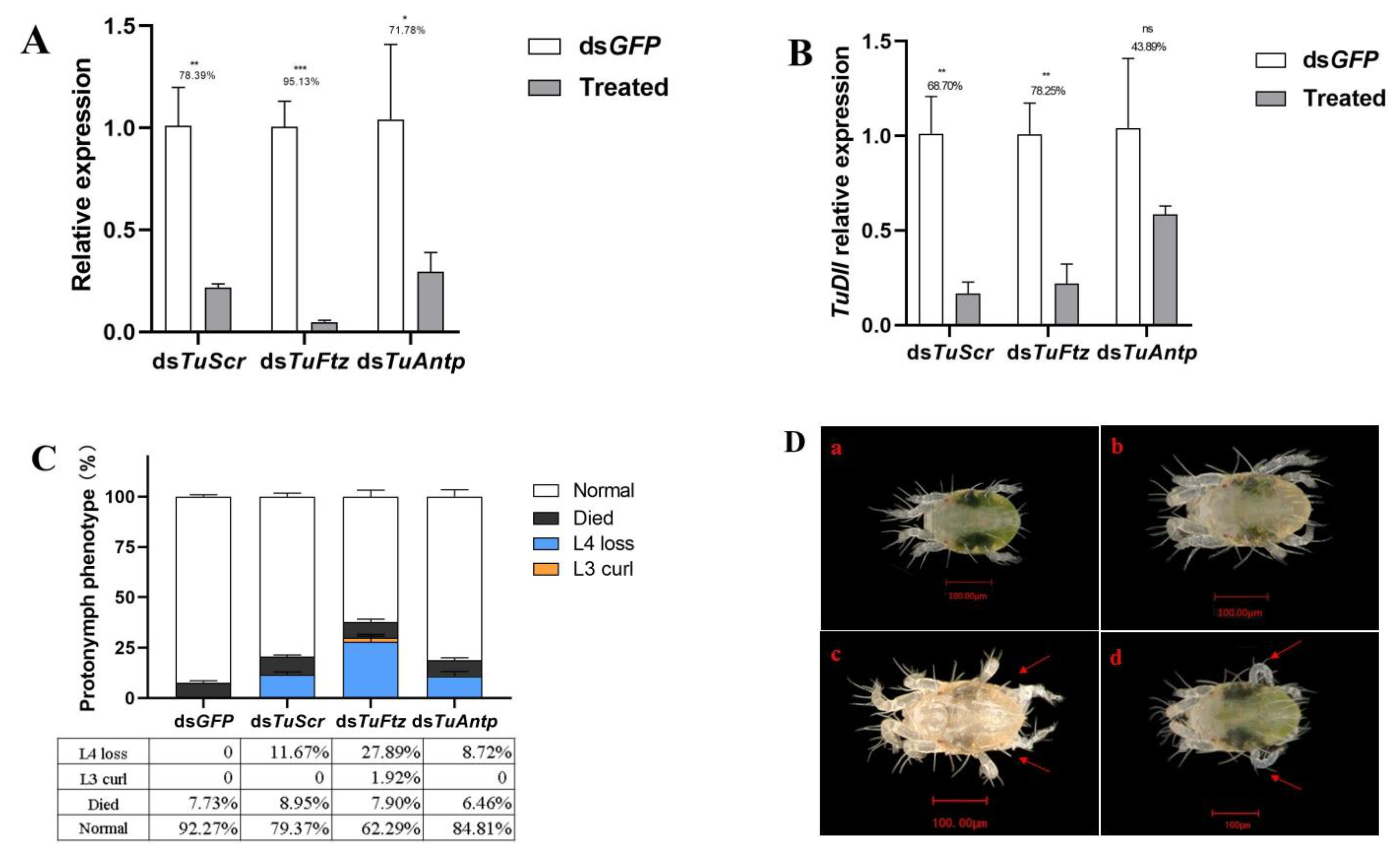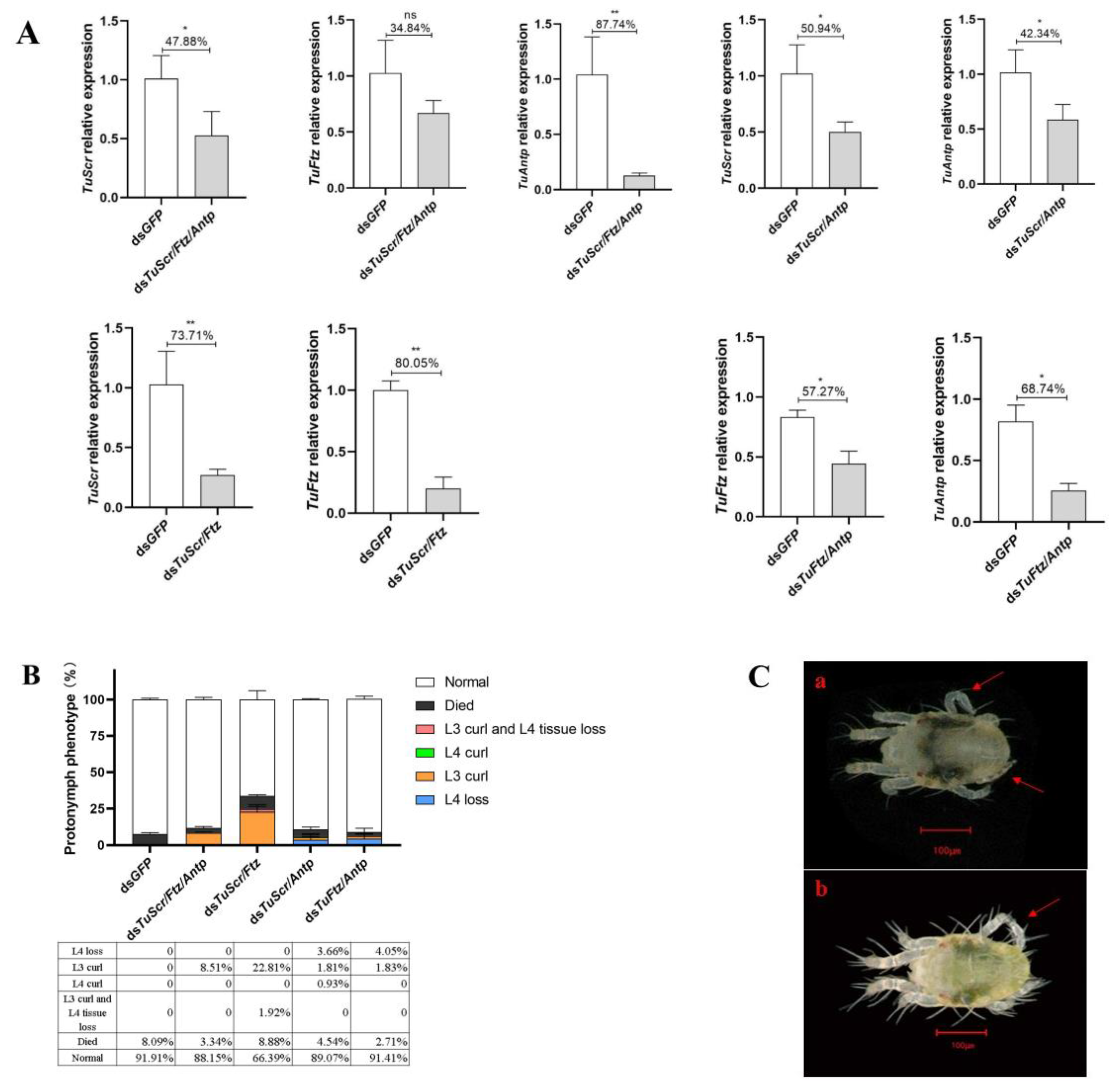Role of the Hox Genes, Sex combs reduced, Fushi tarazu and Antennapedia, in Leg Development of the Spider Mite Tetranychus urticae
Abstract
1. Introduction
2. Results
2.1. Hox Genes Identification, Multiple Sequence Alignment Analysis and Expression Patterns in Different Developmental Stages
2.2. RNA Interference of the Individual Hox Genes Results in L4 Loss
2.3. RNA Interference of Combined Hox Gene Results in L3 Curl
3. Discussion
4. Materials and Methods
4.1. Mites Culture
4.2. Molecular Cloning and Multiple Sequence Alignment of Genes
4.3. Preparation of the dsRNA Formulation and the RNAi Effect Detection
4.4. Real-Time Quantitative PCR
5. Conclusions
Author Contributions
Funding
Institutional Review Board Statement
Informed Consent Statement
Data Availability Statement
Conflicts of Interest
Appendix A
| Gene Name | Direction | Primer Sequences |
|---|---|---|
| Scr | Forward-1 | CGTCACCCATTATCATCAAGCATCA |
| Reverse-1 | CACAACCAGCACCAGCACCT | |
| Forward-2 | TCCTCACTCTCATACTCACCATAG | |
| Reverse-2 | CGGTATCATCGGCTACACTTG | |
| Forward-3 | CATTAACTGGTAGTGGTCTGGTT | |
| Reverse-3 | TTCTTCTTCCTCCTTTGCGTTT | |
| Ftz | Forward-1 | GGGAGAGGAAAGAGCGAGAG |
| Reverse-1 | GTGCGGATGGTGAGGTGAT | |
| Forward-2 | GAGGTGGAAGTGTAAGTGTAAGT | |
| Reverse-2 | GATTGTTGTTGTTGCTGCTGTT | |
| Forward-3 | GTCTCCTATCACACCATCATCATC | |
| Reverse-3 | GGCTCCTTCTTCTGTTTCATCC | |
| Forward-4 | ACACTTCATCTCACCGAACGA | |
| Reverse-4 | GACCAATGTCATGTTGGATAGTTC | |
| Antp | Forward-1 | ATGTGTGATATGAGTCCATATTTTACCA |
| Reverse-1 | TTAGTGTTCCAGTTTACTTACTAGTGG | |
| Forward-2 | ACATCAAAGTGCTGGAATCTCAACA | |
| Reverse-2 | CCTGTCCCTGTTACTGGTCCTC |
| Primer Name | Primer Sequences |
|---|---|
| dsScr-F | TAATACGACTCACTATAGGGTCCTCACTCTCATACTCACCATAG |
| dsScr-R | TAATACGACTCACTATAGGGCGGTATCATCGGCTACACTTG |
| dsFtz-F | TAATACGACTCACTATAGGGGAGGTGGAAGTGTAAGTGTA |
| dsFtz-R | TAATACGACTCACTATAGGGATGATGGTGTGATAGGAGAC |
| dsAntp-F | TAATACGACTCACTATAGGGGACACATGCTACAAGTATCG |
| dsAntp-R | TAATACGACTCACTATAGGGATTGGCTCCTGATGAACC |
| dsGFP-F | TAATACGACTCACTATAGGGGCCAACACTTGTCACTACTT |
| dsGFP-R | TAATACGACTCACTATAGGGGGAGTATTTTGTTGATAATGGTCG |
| Primer Name | Primer Sequences |
|---|---|
| q-Scr | F-GTCGTCGGCGTATTGAAATTGC |
| R-GAGGAGGAACCATGCTGGAACT | |
| q-Ftz | F-ATGAACCCAGCGGCATATACGG |
| R-ACCACCACCACCAAGTCCAGAT | |
| q-Antp | F-TCAACAAACATCAATACCACCGTCTCA |
| R-ACACCTCCGCCTCCACAATCAT | |
| q-ATP | F-CCCGAAGAGATGATCCAAACTG |
| R-CGGTAAACCTGATGCTGAGAAA |
References
- Lewis, E.B. A gene complex controlling segmentation in Drosophila. Nature 1978, 276, 565–570. [Google Scholar] [CrossRef]
- Struhl, G. A homoeotic mutation transforming leg to antenna in Drosophila. Nature 1981, 292, 635–638. [Google Scholar] [CrossRef] [PubMed]
- Regulski, M.; Harding, K.; Kostriken, R.; Karch, F.; Levine, M.; McGinnis, W. Homeobox genes of the Antennapedia and bithorax complexes of Drosophila. Cell 1985, 43, 71–80. [Google Scholar] [CrossRef] [PubMed]
- Hughes, C.L.; Kaufman, T.C. RNAi analysis of Deformed, proboscipedia and Sex combs reduced in the milkweed bug Oncopeltus fasciatus: Novel roles for Hox genes in the hemipteran head. Development 2000, 127, 3683–3694. [Google Scholar] [CrossRef]
- Akam, M.; Dawson, I.; Tear, G. Homeotic genes and the control of segment diversity. Development 1988, 104, 123–133. [Google Scholar] [CrossRef]
- Pearson, J.C.; Lemons, D.; McGinnis, W. Modulating Hox gene functions during animal body patterning. Nat. Rev. Genet. 2005, 6, 893–904. [Google Scholar] [CrossRef]
- Hughes, C.L.; Kaufman, T.C. Hox genes and the evolution of the arthropod body plan. Evol. Dev. 2002, 4, 459–499. [Google Scholar] [CrossRef] [PubMed]
- Levine, M.; Hafen, E.; Garber, R.L.; Gehring, W.J. Spatial distribution of Antennapedia transcripts during Drosophila development. EMBO J. 1983, 2, 2037–2046. [Google Scholar] [CrossRef]
- Carroll, S.B.; Laymon, R.A.; McCutcheon, M.A.; Riley, P.D.; Scott, M.P. The localization and regulation of Antennapedia protein expression in Drosophila embryos. Cell 1986, 47, 113–122. [Google Scholar] [CrossRef]
- Gibson, G.; Gehring, W.J. Head and thoracic transformations caused by ectopic expression of Antennapedia during Drosophila development. Development 1988, 102, 657–675. [Google Scholar] [CrossRef]
- Vachon, G.; Cohen, B.; Pfeifle, C.; McGuffin, M.E.; Botas, J.; Cohen, S.M. Homeotic genes of the Bithorax complex repress limb development in the abdomen of the Drosophila embryo through the target gene Distal-less. Cell 1992, 71, 437–450. [Google Scholar] [CrossRef]
- Mann, R.S.; Lelli, K.M.; Joshi, R. Hox specificity unique roles for cofactors and collaborators. Curr. Top. Dev. Biol. 2009, 88, 63–101. [Google Scholar]
- Nagata, T.; Suzuki, Y.; Ueno, K.; Kokubo, H.; Xu, X.; Hui, C.; Hara, W.; Fukuta, M. Developmental expression of the Bombyx Antennapedia homologue and homeotic changes in the Nc mutant. Genes Cells 1996, 1, 555–568. [Google Scholar] [CrossRef]
- Shiga, Y.; Yasumoto, R.; Yamagata, H.; Hayashi, S. Evolving role of Antennapedia protein in arthropod limb patterning. Development 2002, 129, 3555–3561. [Google Scholar] [CrossRef]
- Khadjeh, S.; Turetzek, N.; Pechmann, M.; Schwager, E.E.; Wimmer, E.A.; Damen, W.G.M.; Prpic, N.M. Divergent role of the Hox gene Antennapedia in spiders is responsible for the convergent evolution of abdominal limb repression. Proc. Natl. Acad. Sci. USA 2012, 109, 4921–4926. [Google Scholar] [CrossRef] [PubMed]
- Galant, R.; Carroll, S.B. Evolution of a transcriptional repression domain in an insect Hox protein. Nature 2002, 415, 910–913. [Google Scholar] [CrossRef] [PubMed]
- Ronshaugen, M.; McGinnis, N.; McGinnis, W. Hox protein mutation and macroevolution of the insect body plan. Nature 2002, 415, 914–917. [Google Scholar] [CrossRef] [PubMed]
- Telford, M.J. Evidence for the derivation of the Drosophila fushi tarazu gene from a Hox gene orthologous to lophotrochozoan Lox5. Curr. Biol. 2000, 10, 349–352. [Google Scholar] [CrossRef]
- Telford, M.J.; Thomas, R.H. Expression of homeobox genes shows chelicerate arthropods retain their deutocerebral segment. Proc. Natl. Acad. Sci. USA 1998, 95, 10671–10675. [Google Scholar] [CrossRef]
- Khila, A.; Grbic, M. Gene silencing in the spider mite Tetranychus urticae: dsRNA and siRNA parental silencing of the Distal-less gene. Dev. Genes Evol. 2007, 217, 241–251. [Google Scholar] [CrossRef]
- Gainett, G.; Klementz, B.C.; Blaszczyk, P.O.; Bruce, H.S.; Patel, N.H.; Sharma, P.P. Dual functions of labial resolve the Hox logic of chelicerate head segments. Mol. Biol. Evol. 2023, 40, msad037. [Google Scholar] [CrossRef] [PubMed]
- Martin, A.; Serano, J.M.; Jarvis, E.; Bruce, H.S.; Wang, J.; Ray, S.; Barker, C.A.; O’Connell, L.C.; Patel, N.H. CRISPR/Cas9 mutagenesis reveals versatile roles of Hox genes in crustacean limb specification and evolution. Curr. Biol. 2016, 26, 14–26. [Google Scholar] [CrossRef] [PubMed]
- Loker, R.; Sanner, J.E.; Mann, R.S. Cell-type-specific Hox regulatory strategies orchestrate tissue identity. Curr. Biol. 2021, 31, 4246–4255. [Google Scholar] [CrossRef] [PubMed]
- Diaz-de-la-Loza, M.D.; Loker, R.; Mann, R.S.; Thompson, B.J. Control of tissue morphogenesis by the Hox gene Ultrabithorax. Development 2020, 147, 29. [Google Scholar] [CrossRef]
- Lohr, U.; Yussa, M.; Pick, L. Drosophila fushi tarazu: A gene on the border of homeotic function. Curr. Biol. 2001, 11, 1403–1412. [Google Scholar] [CrossRef]
- Chen, P.; Tong, X.L.; Li, D.D.; Fu, M.Y.; He, S.Z.; Hu, H.; Xiang, Z.H.; Lu, C.; Dai, F.Y. Antennapedia is involved in the development of thoracic legs and segmentation in the silkworm, Bombyx mori. Heredity 2013, 111, 182–188. [Google Scholar] [CrossRef]
- Mouchel-Vielh, E.; Blin, M.; Rigolot, C.; Deutsch, J.S. Expression of a homologue of the fushi tarazu (ftz) gene in a cirripede crustacean. Evol. Dev. 2002, 4, 76–85. [Google Scholar] [CrossRef]
- Hughes, C.L.; Kaufman, T.C. Exploring the myriapod body plan: Expression patterns of the ten Hox genes in a centipede. Development 2002, 129, 1225–1238. [Google Scholar] [CrossRef]
- Singh, N.P.; Krumlauf, R. Diversification and functional evolution of Hox proteins. Front. Cell Dev. Biol. 2022, 10, 798812. [Google Scholar] [CrossRef]
- De Kumar, B.; Darland, D.C. The Hox protein conundrum: The “specifics” of DNA binding for Hox proteins and their partners. Dev. Biol. 2021, 477, 284–292. [Google Scholar] [CrossRef]
- Singh, N.P.; De Kumar, B.; Paulson, A.; Parrish, M.E.; Zhang, Y.; Florens, L.; Conaway, J.W.; Si, K.; Krumlauf, R. A six-amino-acid motif is a major determinant in functional evolution of Hox1 proteins. Genes Dev. 2020, 34, 1680–1696. [Google Scholar] [CrossRef]
- Khila, A.; Abouheif, E.; Rowe, L. Evolution of a novel appendage ground plan in water striders is driven by changes in the Hox gene Ultrabithorax. PLoS Genet. 2009, 5, e1000583. [Google Scholar] [CrossRef] [PubMed]
- Mastick, G.S.; Mckay, R. Identification of target genes regulated by homeotic proteins in Drosophila melanogaster through genetic selection of Ultrabithorax protein-binding sites in yeast. Genetics 1995, 139, 349–363. [Google Scholar] [CrossRef] [PubMed]
- Botas, J.; Auwers, L. Chromosomal binding sites of Ultrabithorax homeotic proteins. Mech. Dev. 1996, 56, 129–138. [Google Scholar] [CrossRef] [PubMed]
- Dearden, P.K.; Donly, C.; Grbic, M. Expression of pair-rule gene homologues in a chelicerate: Early patterning of the two-spotted spider mite Tetranychus urticae. Development 2002, 129, 5461–5472. [Google Scholar] [CrossRef]
- Grbic, M.; Van Leeuwen, T.; Clark, R.M.; Rombauts, S.; Rouze, P.; Grbic, V.; Osborne, E.J.; Dermauw, W.; Ngoc, P.C.; Ortego, F.; et al. The genome of Tetranychus urticae reveals herbivorous pest adaptations. Nature 2011, 479, 487–492. [Google Scholar] [CrossRef]
- Greenhalgh, R.; Dermauw, W.; Glas, J.J.; Rombauts, S.; Wybouw, N.; Thomas, J.; Alba, J.M.; Pritham, E.J.; Legarrea, S.; Feyereisen, R.; et al. Genome streamlining in a minute herbivore that manipulates its host plant. Elife 2020, 9, e56689. [Google Scholar] [CrossRef]
- Hoy, M.A.; Waterhouse, R.M.; Wu, K.; Estep, A.S.; Ioannidis, P.; Palmer, W.J.; Pomerantz, A.F.; Simao, F.A.; Thomas, J.; Jiggins, F.M.; et al. Genome sequencing of the Phytoseiid Predatory Mite Metaseiulus occidentalis reveals completely atomized Hox genes and superdynamic intron evolution. Genome Biol. Evol. 2016, 8, 1762–1775. [Google Scholar] [CrossRef]
- Xu, J.; Wang, Q.; Wang, S.; Huang, W.; Xie, Y.; Gu, X.; He, R.; Peng, X.; Wu, S.; Yang, G. Comparative genomics of Sarcoptes scabiei provide new insights into adaptation to permanent parasitism and within-host species divergence. Transbound. Emerg. Dis. 2022, 69, 3468–3484. [Google Scholar] [CrossRef]
- Lewis, D.L.; DeCamillis, M.; Bennett, R.L. Distinct roles of the homeotic genes Ubx and abd-A in beetle embryonic abdominal appendage development. Proc. Natl. Acad. Sci. USA 2000, 97, 4504–4509. [Google Scholar] [CrossRef]
- Ueno, K.; Hui, C.C.; Fukuta, M.; Suzuki, Y. Molecular analysis of the deletion mutants in the E homeotic complex of the silkworm Bombyx mori. Development 1992, 114, 555–563. [Google Scholar] [CrossRef]
- Niwa, N.; Akimoto-Kato, A.; Niimi, T.; Tojo, K.; Machida, R.; Hayashi, S. Evolutionary origin of the insect wing via integration of two developmental modules. Evol. Dev. 2010, 12, 168–176. [Google Scholar] [CrossRef] [PubMed]
- Li, G.; Niu, J.Z.; Zotti, M.; Sun, Q.Z.; Zhu, L.; Zhang, J.; Liao, C.Y.; Dou, W.; Wei, D.D.; Wang, J.J.; et al. Characterization and expression patterns of key ecdysteroid biosynthesis and signaling genes in a spider mite (Panonychus citri). Insect Biochem. Mol. Biol. 2017, 87, 136–146. [Google Scholar] [CrossRef] [PubMed]
- Li, X.; Liu, R.; Li, G.; Jin, D.; Guo, J.; Ochoa, R.; Yi, T. Identification of the fibroin of Stigmaeopsis nanjingensis by a nanocarrier-based transdermal dsRNA delivery system. Exp. Appl. Acarol. 2022, 87, 31–47. [Google Scholar] [CrossRef] [PubMed]
- Niu, J.Z.; Yang, W.J.; Tian, Y.; Fan, J.Y.; Ye, C.; Shang, F.; Ding, B.Y.; Zhang, J.; An, X.; Yang, L.; et al. Topical dsRNA delivery induces gene silencing and mortality in the pea aphid. Pest Manag. Sci. 2019, 75, 2873–2881. [Google Scholar] [CrossRef]
- Yang, C.; Pan, H.; Liu, Y.; Zhou, X. Stably expressed housekeeping genes across developmental stages in the two-spotted spider mite, Tetranychus urticae. PLoS ONE 2015, 10, e0120833. [Google Scholar] [CrossRef] [PubMed]




Disclaimer/Publisher’s Note: The statements, opinions and data contained in all publications are solely those of the individual author(s) and contributor(s) and not of MDPI and/or the editor(s). MDPI and/or the editor(s) disclaim responsibility for any injury to people or property resulting from any ideas, methods, instructions or products referred to in the content. |
© 2023 by the authors. Licensee MDPI, Basel, Switzerland. This article is an open access article distributed under the terms and conditions of the Creative Commons Attribution (CC BY) license (https://creativecommons.org/licenses/by/4.0/).
Share and Cite
Luo, X.; Xu, Y.-Q.; Jin, D.-C.; Guo, J.-J.; Yi, T.-C. Role of the Hox Genes, Sex combs reduced, Fushi tarazu and Antennapedia, in Leg Development of the Spider Mite Tetranychus urticae. Int. J. Mol. Sci. 2023, 24, 10391. https://doi.org/10.3390/ijms241210391
Luo X, Xu Y-Q, Jin D-C, Guo J-J, Yi T-C. Role of the Hox Genes, Sex combs reduced, Fushi tarazu and Antennapedia, in Leg Development of the Spider Mite Tetranychus urticae. International Journal of Molecular Sciences. 2023; 24(12):10391. https://doi.org/10.3390/ijms241210391
Chicago/Turabian StyleLuo, Xiang, Yu-Qi Xu, Dao-Chao Jin, Jian-Jun Guo, and Tian-Ci Yi. 2023. "Role of the Hox Genes, Sex combs reduced, Fushi tarazu and Antennapedia, in Leg Development of the Spider Mite Tetranychus urticae" International Journal of Molecular Sciences 24, no. 12: 10391. https://doi.org/10.3390/ijms241210391
APA StyleLuo, X., Xu, Y.-Q., Jin, D.-C., Guo, J.-J., & Yi, T.-C. (2023). Role of the Hox Genes, Sex combs reduced, Fushi tarazu and Antennapedia, in Leg Development of the Spider Mite Tetranychus urticae. International Journal of Molecular Sciences, 24(12), 10391. https://doi.org/10.3390/ijms241210391






